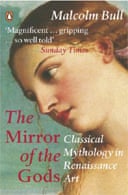The Mirror of the Gods: Classical Mythology in Renaissance Art
by Malcolm Bull
(Penguin, £12.99)
The news that a Greek court has reversed a ban on worship of the ancient Olympian divinities is wonderful. A monotheistic religion requires either submission or rejection; the inscrutable screw-ups on Olympus require nothing more than superstitious propitiation. Not all see it that way: Father Eustathios Kollas, a spokesman for a group of Greek Orthodox priests, described those who would seek to reinstate Zeus et al as "a handful of miserable resuscitators of a degenerate dead religion who wish to return to the monstrous dark delusions of the past".
One wonders how he would have felt during the Renaissance. As more and more ancient texts were rediscovered, and ancient statuary unearthed or re-evaluated, there was a veritable explosion of representations of the pagan deities. Kollas's more celebrated predecessor, Savonarola, was particularly outraged, and invited Florentines to burn their saucy pictures of the heathen gods.
Everyone who knows the tiniest thing about art knows this. The ubiquity of classical imagery at that time was so complete that it simply seems a given. But every so often someone will step back and ask what on earth could have been going on; how could the popularity or desirability of images of a pre-Christian era be accounted for - in a Christian era?
Opinion over the years has generally see-sawed between saying "don't worry about it; they're just nice to look at, and the stories are great", and "there is extremely arcane symbolism and significance to the positioning of every image, pay very close attention". At the moment the latter view prevails - which is why this book has caused something of a flap in art-historical circles.
Malcolm Bull, head of art history at Oxford University's Ruskin School of Drawing and Fine Art, has written an extremely learned work which shows just how free artists were in their use of the mythological source material. We are not to fall into the error of reading too much into the images. The myths were fairytales: a break from the emotional demands or moral exhortations of Christian art. "The Scriptures and the lives of the saints were not a rich source of erotic imagery."
Bull brings a breezy style to what can be the most drily treated of subjects. Of the vogue for portrayals of Jupiter's extra-marital romps, he says: "There were two main audiences for depictions of the loves of Jupiter: anonymous consumers of pornography, and the Holy Roman Emperor [Charles V]." The Muses were "a lot of the time ... just another girl group". "Swimming and going for strolls along the seashore is not the kind of thing that Hercules had time for in the 15th century, and with nothing to do he fell into bad company."
These are more than the kind of gags academics put into their lectures to keep the students happy. The point about Hercules is well made: that it took a long time for Renaissance artists to remember that Hercules wasn't only the man who chose Virtue over Pleasure; he was also a celebrated piss-artist. But, qua stylistic tic, these unacademic asides are not there to tell us he's one of the lads: they're a means of reminding us what it would have meant to have looked at the paintings at the time.
The book is arranged by subject, so chapters on Hercules, Jupiter, Venus, Bacchus, Diana and Apollo are bookended by a contextual background and an epilogue. You will learn as much about mythology as you will about art. I suppose it is the job of an art historian to know all this kind of stuff, but how he manages to cram in so much learning - from all the variant ancient literary sources, to an uncountable number of Renaissance interpretations - is quite astonishing. I saw a review of this book which complained that Bull had nothing to say "about the relationship between iconographies developed as part of the competitive Renaissance flowerings of Habsburg Europe and the Ottoman empire". True. Neither does he shed any light on cold fusion or the best way to make meringues. Such matters are not his concern, and besides, he has plenty to be getting on with.
